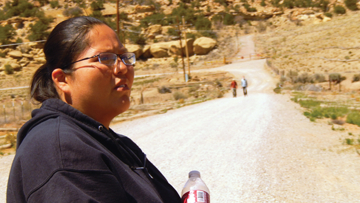
Teracita Keyanna stands on Red Pond Road, which is located between the site of the largest release of radioactive materials in U.S. history and two of the largest abandoned uranium mines. Photo by Talli Nauman / Native Sun News
The Arizona Republic ran a three-part series on the toxic legacy of uranium mining on the Navajo Nation. Mining put tribal members to work and generated revenues for the tribal government. But it's led to numerous health problems, including cancer, organ failure and kidney disease, and has contaminated water and land throughout the reservation. The Environmental Protection Agency has identified 520 abandoned mines and 240 water sources that need remediation. Cleanup could take 100 years. A $1 billion settlement announced by the Obama administration in April will address only 49 sites. Another $3 billion or $4 billion will be needed to clean up the rest, an attorney with the Navajo Department of Justice said. Get the Story:
Abandoned uranium mines continue to haunt Navajos on reservation (The Arizona Republic 8/4)
With uranium poisoning wells, Navajos must drive miles to get drinking water (The Arizona Republic 8/5)
Uranium-mine cleanup on Navajo Reservation could take 100 years (The Arizona Republic 8/6) Related Stories:
Navajo Nation to see $1B from settlement for uranium cleanup (4/4)
Join the Conversation